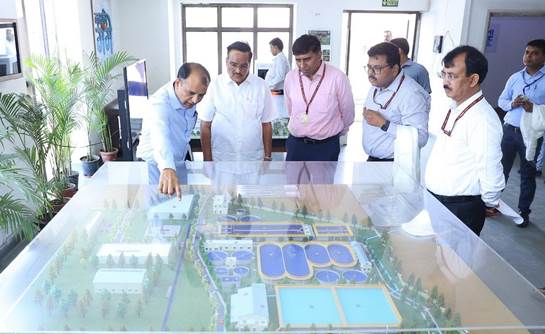Table of contents
The Union Jal Shakti Ministry's launch of the e-flow ecological monitoring system is indeed a significant development in the realm of river management and environmental conservation.

Let's break down the key aspects of this initiative:
Background
- The Government of India mandated in 2018 minimum E-flow for various stretches of the Ganga River to be maintained year-round.
- Following this, the National Mission for Clean Ganga (NMCG), an arm of the Jal Shakti Ministry, laid down the flow specifications essential for -
- Preserving the river's ecological balance, safeguarding aquatic life, and
- Ensuring sustainability amidst diverse water usage demands.
- From the upper Ganga Basin to its confluences and beyond, stringent measures are in place to ensure compliance with E-flow norms, benefiting both existing and future projects.
- With monitoring and regulatory mechanisms, Ganga's ecological resilience is being safeguarded for generations to come.
What is E-Flows?
Environmental Flows (E-flows) refers to the quantity, timing, and quality of water flows required to sustain freshwater and estuarine ecosystems and the human livelihoods that depend on these ecosystems.

E-flow Ecological Monitoring System
- Real-time Monitoring: The system allows for real-time monitoring of river quality, which is crucial for planning and monitoring various projects.
- Data Utilization: It uses data from quarterly reports by the Central Water Commission to track key parameters such as inflow, outflow, and mandated E-flow across 11 projects along the Ganga Main Stream.

Key Features
- Monitoring River Quality: The system monitors the water quality of the Ganga, Yamuna, and their tributaries.
- Namami Gange Programme: It includes monitoring the performance of sewage treatment plants (STPs) to ensure they operate at their rated capacity.
- Central Level Monitoring: Activities under the Namami Gange programme are monitored at the central level.

Recent Developments
- Minister's Commitment: The new Jal Shakti Minister, C.R. Patil, emphasized completing ongoing projects within the stipulated time frame and developing new strategies for areas without river rejuvenation programmes.
- Innovative Solutions: There is a focus on innovative solutions to address emerging challenges in river management.
E-flows Mandated Levels
- Minimum E-flow: In 2018, the Centre mandated a minimum e-flow for various stretches of the Ganga to be maintained year-round. This was in response to concerns that dams were impeding the river's flow and harming its ecology.

- Upper Ganga - 2 % of monthly average flow of the preceding 10 days during the dry season (Nov to Mar) and 25% during monsoon season (Jun to Sept).
- Middle Ganga - 25 % of monthly average flow of the preceding 10 days during the dry season (Nov to Mar) and 30% during monsoon season (Jun to Sept).
- Lower Ganga - 30 % of monthly average flow of the preceding 10 days during the dry season (Nov to Mar)and 35% during monsoon season (Jun to Sept).
Importance of E-flow
- Biodiversity Conservation: Ensures the survival of aquatic species by maintaining their natural habitats.
- Ecological Balance: Maintaining e-flows is crucial for sustaining the river's ecology and ensuring that aquatic life and other ecological processes are not disrupted.
- Water Quality: Helps in diluting pollutants and maintaining water quality.
- Sediment Transport: Facilitates the natural movement of sediments, which is essential for maintaining river morphology.
- Livelihoods: Supports the livelihoods of communities dependent on river ecosystems for fishing, agriculture, and other activities.
Implications
For River Management:
- Enhanced Monitoring: The e-flow monitoring system enhances the ability to monitor and manage river water quality and flow in real-time.
- Data-Driven Decisions: The availability of real-time data allows for more informed decision-making and timely interventions.
For Environmental Conservation:
- Sustainable Flow: Ensuring continuous and sustainable flow of rivers like the Ganga is vital for maintaining their ecological health.
- Addressing Challenges: The focus on innovative solutions and new strategies will help address the challenges faced in river rejuvenation efforts.
Implementation in India
In India, the concept of E-flow has gained significant attention due to the increasing stress on water resources. The National Mission for Clean Ganga (NMCG) has been actively involved in implementing E-flow norms for the Ganga River.
Key steps include:
- Policy Framework: The Central Water Commission (CWC) has issued guidelines for maintaining E-flows in rivers.
- Pilot Projects: Various pilot projects have been initiated to demonstrate the feasibility and benefits of E-flow implementation.
- Stakeholder Involvement: Engaging local communities, industries, and other stakeholders in the planning and implementation process.
Initiative - Namami Gange Programme

- Flagship Programme: This is a flagship programme of the Ministry of Jal Shakti aimed at cleaning the Ganga and now includes its tributaries.
- Focus Areas: The programme focuses on ensuring the uninterrupted flow and cleanliness of the Ganga.
Challenges
- Data Availability: Lack of comprehensive data on river flows and ecological parameters.
- Infrastructure: Need for infrastructure to regulate and monitor flows.
- Coordination: Coordination among various government agencies and stakeholders.
- Awareness: Raising awareness about the importance of E-flows among policymakers and the public.
Conclusion
The launch of the e-flow ecological monitoring system by the Union Jal Shakti Ministry marks a significant advancement in river management and environmental conservation. By leveraging real-time data and focusing on innovative solutions, the Ministry aims to ensure the sustainable flow and cleanliness of the Ganga and its tributaries.
Previous Post